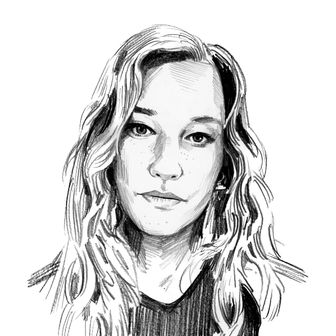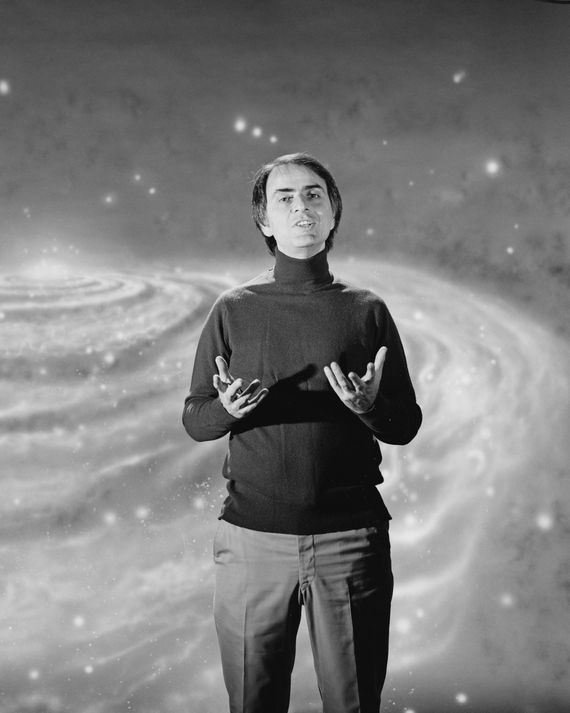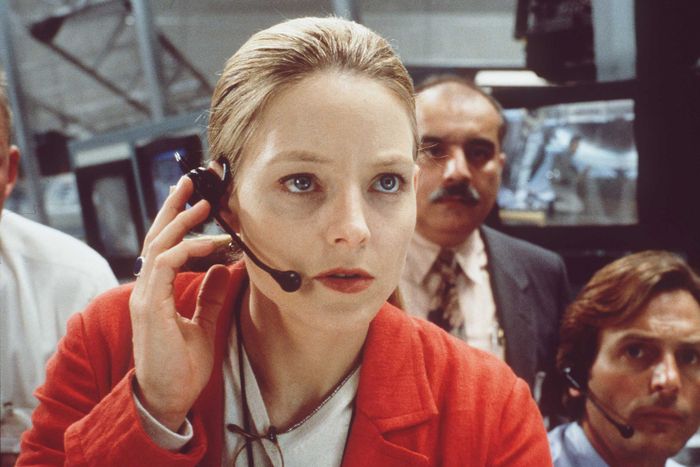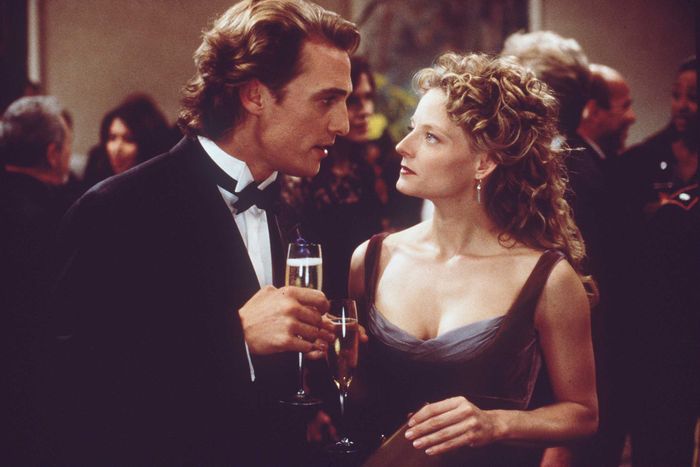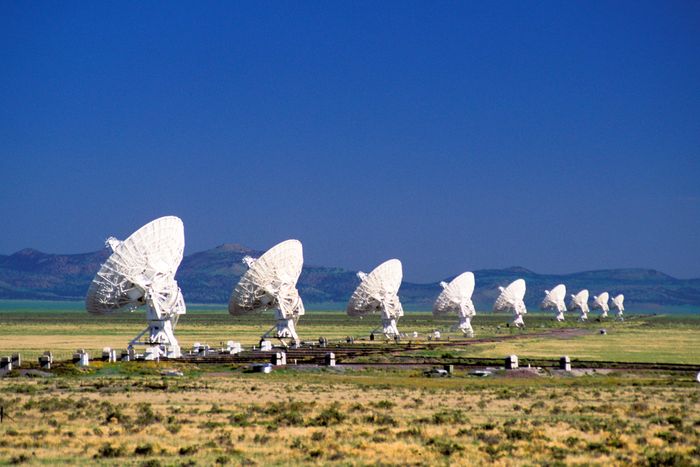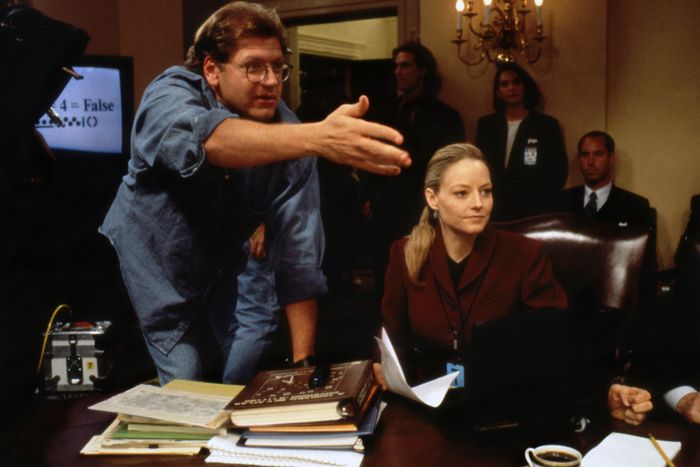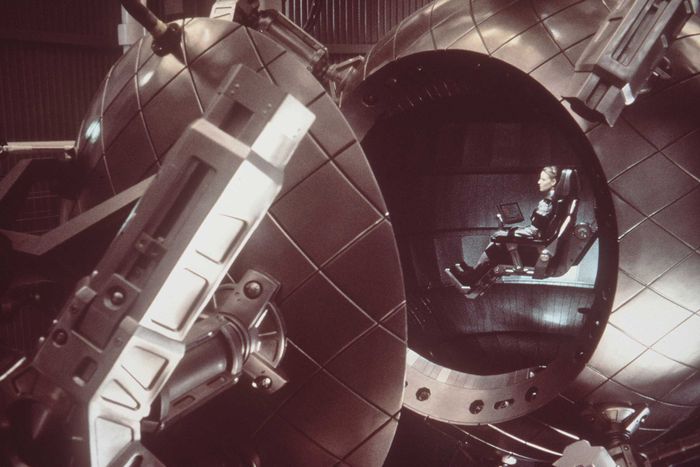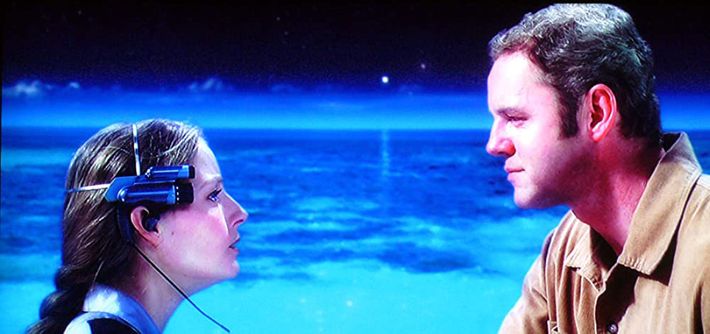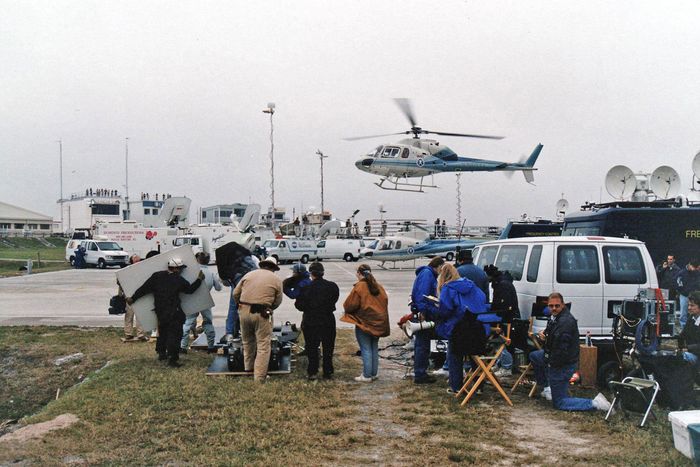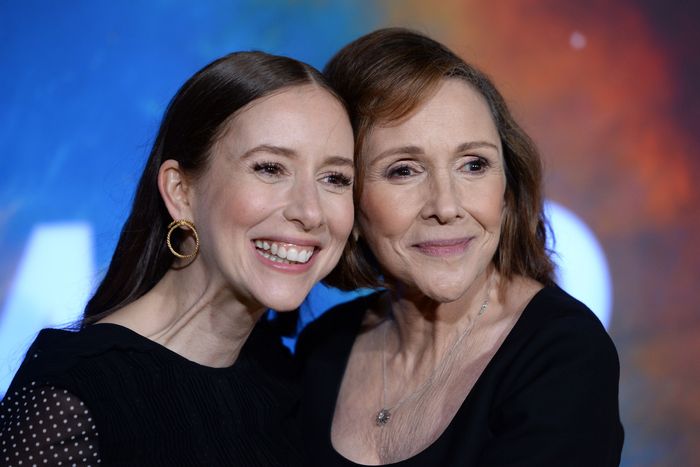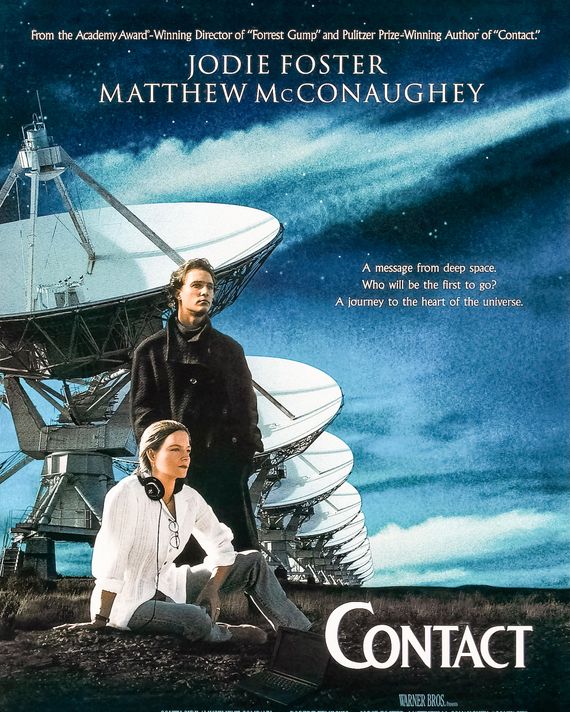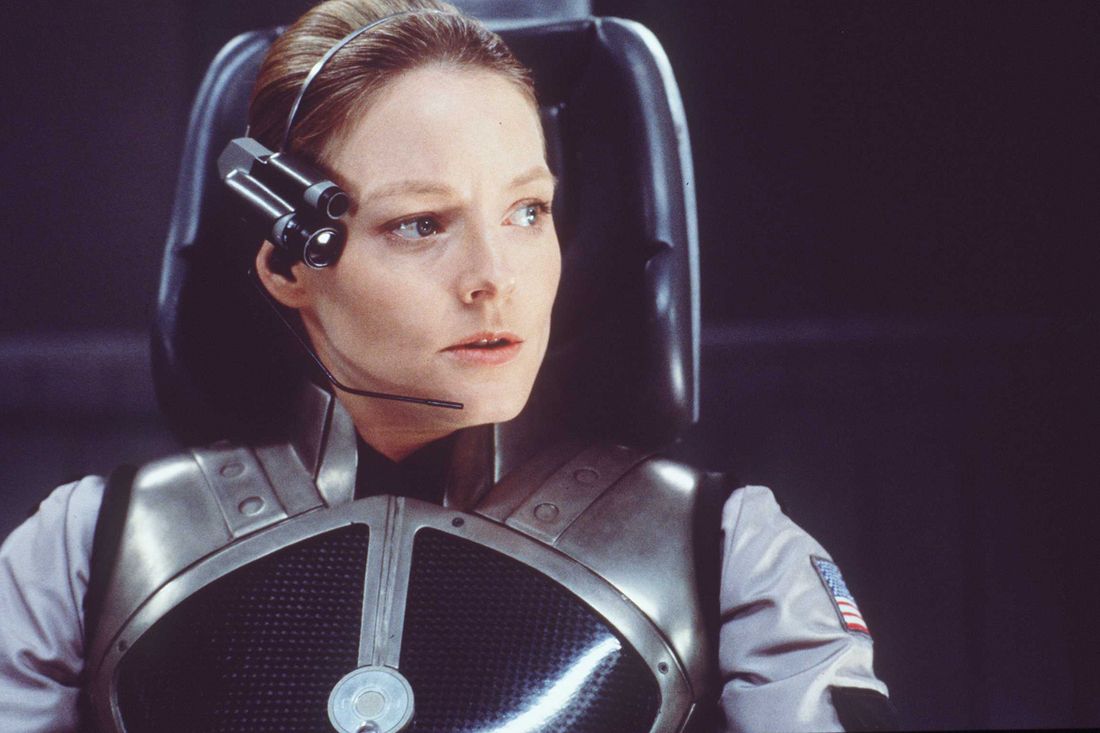
This article was featured in One Great Story, New York’s reading recommendation newsletter. Sign up here to get it nightly.
Carl Sagan and Ann Druyan — a world-famous astronomer and a former creative director at NASA, respectively — could never have anticipated the bliss and chaos that lay ahead when, sitting by a pool one night in Los Angeles in the late 1970s, they decided to co-write a movie about a “spiky” female scientist journeying to the center of the cosmos. What would it look like if we made definitive contact with aliens, they wondered, but only one person experienced it? It took Sagan, Druyan, and a litany of writers, producers, and directors nearly two decades to answer the question. Much like humanity’s interminable search to find intelligent life beyond Earth, the quest to make Contact was marked by heartbreak, hubris, meddling suits, and moments of sublime.
The problems were myriad. At the time, Hollywood was accustomed to journeymen and this was a story about a woman embarking on an intergalactic odyssey while her male counterpart stayed at home. Nearly every screenwriter and filmmaker who tried a hand at Contact’s script fumbled to make the lead character, Ellie Arroway, relatable to male studio executives. There were the film’s aliens, who didn’t kill anyone and didn’t possess any weird body parts like the otherworldly beings of most contemporary sci-fi films to that point. But somehow, rewrite after rewrite, Contact survived despite a hostile atmosphere and several failed attempts at liftoff, a bit dented in places but not destroyed. It finally touched down in movie theaters on July 11, 1997, with director Robert Zemeckis at the helm, Jodie Foster as its headstrong lead, and Matthew McConaughey as a studly Christian philosopher. Tragically, by the time Sagan and Druyan’s long-cherished dream had manifested, he wasn’t around to witness it.
Ahead of Contact’s 25th anniversary, we spoke to nearly two dozen people involved in its making, including Zemeckis, Foster, McConaughey, Druyan, Sasha Sagan, and veteran producer Lynda Obst. They disagreed on several aspects of Contact’s development saga, but settled on some consensus: Contact was a lightning-in-a-bottle project, the kind of thing big movie studios barely made before and would probably never make again — intellectually challenging, emotionally messy, heavy with metaphor, wherein nobody shoots an alien in the face in front of an American flag. “We used to do that,” said Foster. “We used to make movies that were resonant and were entertaining.”
I. Making First Contact
Over the course of its nearly 20-year development process, Contact fell into the hands of dozens of writers, directors, producers, and executives, all of whom had different ideas about how and why Ellie should be shot into the stratosphere in search of intelligent life. For a while, it looked as if Druyan and Sagan, who married in 1981, might lose the character forever thanks to some craven studio machinations.
Ann Druyan: This is 1978. Carl and I are still working on Cosmos. At the time, it was popular to say things like, “Well, if men are as smart as women, then how come there are no female Leonardos? No female Einsteins?” This made both of us furious. I had just co-written the part of Cosmos about the Great Library of Alexandria and the fact that Hypatia, who was the leader of the library, was a mathematician focusing on the Diophantine equations that Newton would later become interested in. Her reward for being the great intellectual light of the library in 415 AD was to be ripped from her chariot that she was driving herself and carved to bits with abalone shells.
People were throwing everything at Carl then. He was such a phenomenon in the culture, and everybody wanted to do something with him. So we knew we could get a book and a movie contract. We agreed one night, sitting in the pool at our little rented house in West Hollywood, that we were going to tell a story in which not only would a woman be the intellectual hero but, in the great tradition of Gilgamesh, she was going to go on the voyage and the guys would stay home.
Lynda Obst, producer: Nora Ephron was one of my best friends and mentors. She gave the greatest dinner parties in the world, and this was a particularly great party in 1974. I remember Nora saying to me when I first walked in, “Lynda, I want you to meet Annie because she likes baseball as much as you do.” We became very close right after.
Ann and Carl met at that party, too. When they were working on Cosmos, it was the first year of my being a movie-development executive. I was miserably unhappy and dislocated from everything that was deep and real to me, but I was so excited they were coming out to stay in Los Angeles for a year.
Druyan: Sometime between 1979 and 1980, Lynda came to us and said, “You guys should really write a movie.” We agreed that I would do the kind of human and emotional parts and he would do all of the science and technical stuff. We would exchange our pages every day as we were weaving the story together. Our daughter, Sasha, was 2 years old.
Sasha Sagan: The first thing that comes to mind is giant whiteboards. They’d be like, “Don’t touch this.”
They really were in love. I would walk into the dining room and just find them — this is such a perfect example of the kind of thing that is horrifying when you’re an adolescent, and now, as an adult person, I see how beautiful it was — just making out.
Druyan: Of course we were stoned while writing Contact. He would do this thing where he would remove this imaginary hat from his head and tip it to me when he was really pleased with something that I wrote. When I read something he wrote that I loved, I would just jump on him and scream. To me, it was the highest form of happiness.
Sagan and Druyan finished their Contact film treatment in 1980. In 1982, a film producer named Peter Guber, then head of Casablanca Records and Filmworks, purchased the treatment and took it to Warner Bros. It would remain in development hell with the studio for seven years.
Druyan: The 110-page treatment was pretty close to a screenplay. But tragically it didn’t come together as a movie project for a long time.
Obst: I was working for Casablanca at the time with Peter Guber, who bought Contact. When I left the company to go off on my own, he continued to develop it — sort of. He gave it to all the wrong directors — the one I can remember is Robert Harling, a mushy, sentimental rom-com writer and director.
Peter changed the hook of the idea. Ann and Carl’s hook was a radio astronomer who’s looking for signals from other civilizations to see if there’s anyone out there. Peter changed it to a woman scientist who had abandoned her son and who goes looking for him — where she should be looking; not at the stars. It was so misogynist it was unbelievable.
Peter tried very hard to separate Contact from Carl. Carl and Annie were exacting about the science, but Peter wanted to make up the science, so he hired somebody named Gentry Lee, who used to work for Carl on the first Cosmos, who was an engineer and perfectly happy to join his first movie project and justify any plot move Peter wanted to make.
In the meantime, Sagan and Druyan wrote the book Contact. It would become a best seller. In a fortuitous twist of events, Warner Bros. removed Gruber from the Contact film project and reinstated Obst as a producer in 1989, this time with James V. Hart attached to the script.
Obst: The first thing I had to do was reunite Carl and Contact after Warner Bros. eventually took it away from Peter. I was doing a different project for Warner Bros., and they said to me, “Could you give us some help on this project we have here called Contact?” I laughed so hard. They had no idea that I’d originally developed it.
James V. Hart, writer: I just kept saying no. It didn’t matter how much money they were going to pay me. I thought it was a very difficult adaptation. It wasn’t the sort of sci-fi movie that was being made at the time: no aliens, no spaceships, no invasion of Earth.
I found out that there had been seven writers on the project before me. I said, “Okay, send me a couple of the scripts.” The only thing their scripts had in common with the book was Ellie Arroway going in a spaceship to the center of the galaxy for a meeting. One had her son stowed away onboard.
Obst: I think the biggest mistake that the people made was that they didn’t understand that it was possible for a woman to want to give her life to knowledge instead of to a husband and child.
Druyan: Let’s put it this way: There were many voices that were trying to make her a more conventional woman.
Hart: I finally asked, “Didn’t anybody talk to Carl about the adaptation?” No one had ever talked to Carl — none of the directors that had been onboard ahead of me or the writers. So Lynda designed a weekend where all of our families got together. That weekend, we found the movie inside the book. Mainly, it was around the father-daughter relationship.
Sagan: Something that has really only just dawned on me in a real way is how much it’s a father-daughter story. I’m going to burst into tears right now.
Hart: In the book, it didn’t really exist. They didn’t have any kind of emotional connection. To Carl and Ann’s credit, they said, “Well, let’s build that.” We worked for another year on the drafts.
Then George Miller came on to direct in 1993.
Obst: We proceeded to go into development with George Miller for a couple of years of rollicking and frolicking. He told Carl and Annie that they should take a pass at the screenplay at some point.
Druyan: On December 4, 1994, we had a conference call after he had read our version of the screenplay, and for the first time, he was completely embracing the material. It was such a moment of joy for me. Later, I was getting a massage in a hotel, and I was lying on the table, thinking, Our kids are good. Carl is good. We created something that a really distinguished director thinks is worthy. And then the phone rang. I got off the table and picked up the phone, and it was Carl’s doctor telling us that Carl’s blood test had come back and that he had a fatal disease. That was the beginning of this two-year struggle to find a way for Carl to survive.
II. The Strange Film That Could Have Been
In 1994, Sagan was diagnosed with myelodysplasia, a rare bone-marrow disease. He and Druyan “tried everything we could” to keep him alive for the next two years, including three bone-marrow transplants, chemotherapy, and radiation. Around this time, Contact development moved ahead under Australian Mad Max director George Miller, who envisioned a “stranger” film that never made it to the screen.
Jodie Foster, Ellie Arroway: The George Miller movie was very different. It was an incredibly long script — like, 200 pages. It was crazy. It felt a little bit more like Lorenzo’s Oil or had even moments of, like, Eraserhead.
Druyan: George Miller was the first one that really got that this had to be edgy and not a formulaic big-budget Hollywood product. He had these seminars with experts on military and social movements and about what happens when the world is traumatized, as we imagine the world would be in the case of a first-contact situation.
It was stranger — because that was the idea. The universe is strange. There were scenes with, like, roadkill that you wouldn’t think were right on the path of the story but which I felt had the power to expand the viewer’s consciousness.
George Miller declined to comment for this story. In a 2015 interview with Collider, he described his version of Contact as less “safe” and less “predictable” than Zemeckis’s movie. He likened his script to another Matthew McConaughey movie (also produced by Lynda Obst), Interstellar. “I’m not saying it was going to be 2001,” he said, “but it was much, much less force-feeding exposition.”
Hart: George brought in Menno Meyjes, a wonderful writer, to work with him on the script. I’d rather not go into Lynda replacing me. I mean, she had every right to. I had done a very difficult adaptation. I think the studio was disappointed because it was too heavy and too mathy.
Menno Meyjes, uncredited writer: I think George and I met at a barbecue. I gave some off-the-cuff, fairly subversive suggestions. I remember what they were, but I’m not going to tell you because in this day in age you get crucified so quickly.
The next thing I know, I’m on the plane to Sydney.
Hart: Menno Meyjes’s work was exceptional. It really brought in the outside world: amped up the media, amped up the threat of the terrorist. The terrorist did not exist in book — I created that.
Meyjes: I was fired before George was fired. People loved the draft except for Jodie.
Obst: George was happy with Menno’s work, but the studio wasn’t. So then we hired Michael Goldenberg, who had done a draft before Menno.
Michael Goldenberg, writer: This was a draft for the studio, to make them happy and make Jodie happy and get it back on track. The consistent problem was Ellie as a character — you didn’t understand her, so you didn’t really empathize or connect with her. But I was that kid, like Carl, who was lonely and read a lot of science fiction and wanted to transcend my mundane circumstances. I saw that in Ellie as a character.
Obst: His script was terrific. Then I gave it to George, and he liked it, but he wanted to keep working on it. So we had our big contretemps: “George, are you going to make this movie this year?” And George was like, “Probably, if the script is there.” And the studio executives said, “Well, we think the script is there.” And he says, “Well, I don’t think it’s there yet.”
The studio organized a really big dum-da-dum kind of meeting. His partner back in Australia was saying to him, “They’re just bluffing.” I kept saying, “George, they’re not bluffing.”
He came into this meeting with a very complicated diagram about what he wanted to do with the script. They said, “George, will you commit to shooting this movie by Christmas?” This was the do-or-die moment. We were all praying he would say yes. He said no. I remember sinking into my chair.
Druyan: George was fired. Warner Bros. wanted a tentpole. They wanted to put it on the schedules. Of course, we were nowhere near that because George was searching and holding these colloquia, and that was his way of doing things. And then he was gone.
Obst: It was very painful for George. It took him a long time to shoot a big movie again. I think it’s a tender spot in his history.
They had Robert Zemeckis on the movie the next day. I’ve always wondered if they had already slipped it to Bob, and they knew when they gave George the ultimatum that they had a backup.
Robert Zemeckis, director: I’ve always been a giant fan of Carl Sagan. I loved the Cosmos series that he did on PBS. I knew when the Contact book came out. But to be honest, I never, ever have been a fan of alien stories. I always shrug at the design of the aliens — how does anyone ever know what to make them look like? An early draft had the sky open up at the end and all the aliens came down to prove that Ellie’s journey was truthful. And I just said, “No, thank you.”
So I passed on it. Then I think I made another movie, and then I made Forrest Gump. Then Contact came back around. The fact that I came onto the script after the release of Forrest Gump probably solidified the idea that I was going to be creatively in charge of the movie. I would not have made any movie without final cut again.
Obst: He didn’t really want to have much of a working relationship with me, I think, because I worked so closely with George.
Goldenberg: Jodie was super-insightful. She had some notes. To have the three of us sit in a room and decide what this movie should be — I didn’t know how good I had it, honestly.
Carl and Annie got a new draft, and we went up to meet with them in Seattle while Carl was getting his treatment. Bob was lovely with them. The things that were really important to them — they were balancing those things with the needs of a two-and-a-half-hour movie.
Hart: It was clear to me when I saw the final shooting script that Goldenberg had done an excellent job folding Menno’s work into the draft. It wasn’t until I saw it that I realized how much of what Carl and Ann and Lynda and I had done had survived and actually been expanded upon.
I got credit on the film in arbitration. Warner Bros. had already put Michael Goldenberg’s name all by itself on so many TV spots and trailers and what have you. They had to go back and change that. There was enormous resentment for me for getting credit because there was a belief that I didn’t really do anything.
Goldenberg: I remember being devastated. You know, it was my first big movie. I felt very proprietary about it. But it’s all water under the bridge at this point.
Hart: Menno did not get credit. And that always disturbed me. He and I actually watched the film together.
Meyjes: I can’t say that I sat there with a giant bucket of popcorn and said to my wife, “Darling, this is going to be a fantastic evening.” I kind of watched it and just thought, What the fuck?
Zemeckis: All I know is that Michael Goldenberg worked his ass off.
Foster: In a weird way, I got to see two different possibilities for Contact. One was the super-philosophical, artsy path. This sort of human disconnection that we feel from everyday life in highly technological life. And the question of faith, and if faith can repair that connection or can science repair that connection. And then the other one was a film that was really grounded in reality and in NASA and in all the things that we know with that wonderful cinematic experience that Robert Zemeckis can bring.
Druyan: I always had this secret fantasy of actually seeing the George movie. But Bob was extremely welcoming of our input. This is not a diss of him in any way.
Obst: I think Zemeckis did a bang-up job. But I wish I could have seen George’s movie.
III. A Rare Kind of Role
How do you solve a problem like Ellie Arroway? Who in Hollywood had the range to play her, the intellect and empathy to understand her? Who was she based on, anyway? And which actor could measure up to her as the high-minded philosopher Palmer Joss? And did he need to be hot?
Obst: There were people vying for Ellie. Julia Roberts wanted to do it. George Miller flirted with Uma Thurman for a second. But there wasn’t really anybody who attached or anybody we all got excited about except for Jodie.
Goldenberg: Every actress in Hollywood wanted the part. It’s a rare kind of role.
Foster: I didn’t have to audition. Pretty sure I had already won two Oscars by then.
William Fichtner, Dr. Kent Clark: It’s hard to describe, but sometimes there are certain actors for certain roles that really shouldn’t have been played by anybody but the person who did, and this is one of those.
Zemeckis: The fact that I was going to work with Jodie was really the main attraction.
Goldenberg: I remember her saying to me once, “Make Ellie spiky! Don’t be afraid to make her spiky.” So many actors, they want to be sympathetic, they want to be likable. And that was just the striking thing: “Make her kind of tough and difficult and myopic, in her way.”
Matthew McConaughey, Palmer Joss: Jodie is nobody’s fool. She’s very direct. I got to know her well enough to know she has a really great sense of humor, but Jodie is no bullshit. I think that speaks to her longevity. You don’t become an institution and remain an institution and remain relevant and in demand for that long if you’re pandering to what you think the business may want of you.
Foster: I think, more than any character that I’ve ever played, Ellie Arroway is the most like me or at least the most like how I think I should be seen — how I see myself or something. She is as deep emotionally as she is prodigious intellectually, and that has caused her to live this kind of solitary life. I wouldn’t call it lonely so much as I would call it solitary. You know, it’s sort of deliciously lonely.
I was not very good at math, and I’m not even sure that I’m great at many things, but the one thing that I did have was this prodigious connection to human behavior and this ability to compartmentalize — to be able to examine something at the same time that I was feeling it. It’s a part of Ellie Arroway and something that connects to me too.
Sagan: The character of Ellie is my parents’ child. They created her together.
Druyan: She was named Eleanor for Eleanor Roosevelt, whom we both adored. “Arroway” because that was Voltaire’s real name but spelled in a different way. Also because of the idea of an arrow way — she was going to travel like an arrow through the cosmos.
She was not based on Jill Tarter. I didn’t get to know Jill, whom I respect and adore, until years after I finished my part of writing. But there is a convergent evolution at work here. Because she was one of the scientists who we introduced Jodie to in order for her to be comfortable with what a woman in science was — Jill, Carolyn Porco.
Obst: There’s another scientist who thinks it’s about her, too. I don’t think I should give you her name. It’ll be too controversial. But trust me, there’s a big planetary scientist who thinks it’s about her. And that’s because we talked to a lot of scientists early on about their isolation in science at the time.
Sagan: The way that Jodie plays Ellie, it just reminds me of my dad so much. She managed to really capture this genuine desire to know if there’s anybody else out there — not to believe but to know.
Obst: The way Ellie talks reminds me more of Annie than Carl. I think Annie’s more of an influence, but she’s not going to say that.
Hart: Jodie was channeling Carl. I finally realized that when I was watching the movie for about the third time and said, “She’s doing Carl.”
Jena Malone, Young Ellie: The part was presented to me as “They’re looking for a young Jodie Foster, and you would be great.” I think that maybe Anjelica Huston put in a good word for me.
They said Jodie wanted to meet me. I was really nervous. We sat and talked. It wasn’t even really about the script. I just could tell she was watching me like a hawk. Zemeckis later told me that she was studying me to see my movements and things to see what she could take so that we could be similar. I guess I tucked my hair behind my ears a lot, and that’s where that movement came from when she’s looking at the satellites and she tucks her hair.
Hart: We created the romance between Ellie and Joss, which was not in the book. I didn’t envision Joss as a stud.
Obst: At that time, it was kind of compulsory to have a romance. Palmer was a great spiritual thinker in the book — it required a person to be a little older and wiser than America’s hottest movie star. But what Warner wants Warner gets, and Matthew was great. You put Matthew in a movie and someone gets attracted to him.
Zemeckis: He’s a very sensual hunk of a man, right? He had just enough Texas twang in his voice. I thought he was perfect.
Sagan: Proximity to him I think expedited my puberty.
Foster: He was quite young. He had only done A Time To Kill at that point. He was really holding on to his Texas roots, and I loved that about him — that even as a very young man, he was concerned that he would be taken away into the fakery of Hollywood.
McConaughey: I’ve never taken an acting class. I stepped into the role of Wooderson in Dazed and Confused and worked for three weeks. I didn’t know what acting was, but I seemed to have instincts for it. The day before Time to Kill opened, I had 100 scripts I would have done at the drop of a hat, and 99 were “No.” Then the weekend after Time to Kill opened, all of the sudden it’s like, out of those 100, 99 were “Yes.”
I went on a little spiritual walkabout for 22 days with myself in Peru. I’ve always been a believer. I had spent time in my life considering being a monk. I came back, and that’s when I made the decisions to do Amistad and Contact. Instead of choosing the lead male role in movies that were being offered to me, I really wanted to choose, What stories do I feel like are worthy and necessary to be shared? I felt it was a philanthropic choice, I dare to say. The fact that it proposed this paradox between science and religion, between science and belief, between science and faith, was a subject that I’d been interested in all my life. I wrote papers about it in college. My belief has always been that science is the practical pursuit of God.
I didn’t audition for it. I did meet with Zemeckis. Then I believe I had to meet with Jodie. Jodie had approval of who played the role of Palmer. Then I got offered the role.
Zemeckis: They looked great together. There’s a truth to this thing called screen chemistry.
Foster: That was a new and interesting thing onscreen — an erotic connection that’s about the brain.
McConaughey: Anybody that’s in a relationship in their own life knows that there’s many ways that people are intimate. With Jodie and I, it was coming together through an intellectual confrontation.
Foster: He did kind of have the “girl’s part,” and I think that was refreshing, honestly, for him. Traditionally in literature, women stay home and men travel. We stay home and think about family, and we have interior lives that, in some ways, explorers don’t have. We got switched. Ellie Arroway is an explorer, she’s a navigator, she’s Galileo. He is the thoughtful one who stays home and talks about the interior life.
McConaughey: “I’m a man of the cloth without the cloth.” That was a line from me that gave me the idea that Palmer Joss, he’s a bit of a renegade. It let me and Bob go, “Yeah, he doesn’t have a haircut right here.” It let him go, “Yeah, unbutton another button on your shirt.”
Zemeckis: The only thing that I got nervous about, because he dug in, was Matthew wanted to play the character with, like, a giant, full, lumberjack beard. I said, “I don’t understand why that character would present himself like this. He’s this sort of media spokesperson.” He finally gave in.
IV. Your God Is Too Small
Almost two decades after Sagan and Druyan sat down by that pool, Contact began filming on September 24, 1996. Just as Sagan did, Contact grapples endlessly with questions of faith and science. Those questions nagged at the cast and filmmakers, too, who regularly engaged in debates about God, the universe — even lines of dialogue that felt a little too sacrilegious.
Foster: I wanted it to feel real. There was no way that I was ever going to have the kind of knowledge that real scientists could have. There was a lot of research that I did that I did not understand, but somebody very smartly bought me children’s books about science and black holes.
Fichtner: I’m a criminal-justice major from Buffalo. I’m not knocking myself, but listen, I played an astrophysicist. Robert Zemeckis, boy, he really wanted to get it right, and there were people around who really explained things to you.
Obst: In the beginning, we had workshops where we brought in experts from all these different areas. There were very serious Christian theologians who talked to us about Joss’s stuff and what apocalyptic Christian thinking meant. Jill Tarter came in and talked to us about radio astronomy. We wanted to get the essential debate between science and religion right. We wanted science to win, but we didn’t want religion to lose.
Foster: Honestly, it was mostly the computers. Nobody was computer literate at the time. I remember the first day with the technical adviser. I’d say, “I don’t understand. What am I doing at my computer?” He sat down and told me, and it took 25 minutes and I didn’t understand anything. Bob came in and said, “Okay, no, no, no. You’re going to hit that key, and then that key and then that key.” I kept wanting to understand, and there was just no way.
Carl was there once during production. He came and gave us a lecture about the cosmos. He wore a little turtleneck, and we got to ask him questions.
McConaughey: We got to be a captive audience to Carl Sagan taking us through the beginning of the world. If I remember correctly, it was like, “If you take a clock and you were looking at it two-dimensionally, it would be at the tip of the left corner of the top of the five on the clock. That’s our galaxy that we’re in. It’s ever expanding, and there are many universes.”
I was on the edge of my seat the entire time. Everything he had said was filling me up and making me more of a believer than I already was. He got to the very end and he goes, “And therefore God doesn’t exist.” I went, “Wait a minute. You had me believing God existed more than ever, and that’s your punch line?” He was like, “Yep. I’d love to discuss it.”
Obst: Carl would never get in the way of the characters, but if there was some assertion that was untrue or it could be qualified better to make it true — he was always checking the science. For example, Ellie was initially traveling to a black hole. Carl sent the novel to Kip Thorne. Kip was the world’s expert on black holes. He did some calculations, and he said, “They’re going through a wormhole.” And that’s when Carl rewrote that section of the novel to be a wormhole.
That’s the kind of checking he did. We can’t say that it’s accurate that there’s a wormhole or that if they were another intelligent society, that intelligence could read our memories and our minds and come to us in whatever corporal form they chose, that this life formed at the center of the galaxy could turn itself into a hologram of her father. It could be speculative, but it couldn’t break the laws of physics.
Druyan: What Carl and I wanted was Eleanor Arroway as a skeptic. But then she has this contact experience where she goes to see her father in heaven, and what a great way to turn her inside out. Because she literally believes that she saw her father in heaven.
We also wanted Palmer Joss to realize that his God was just too small — he wasn’t big enough for the universe, and science reveals that. But Matthew would not do it. I didn’t want him to become like Richard Dawkins, but I wanted him to say these words: “My God was too small.”
Obst: It’s what Carl really feels about people who think that God would not have put other intelligences in the universe. That’s a small God. But a God who can conceive of a birthing forth of life forms — that’s a big God.
McConaughey: I can’t imagine saying that line because that would have undercut who I was. That was a lie. I can’t go on and lie on my character. To play a character who believes at the end “Oh, my God was too small” is different than saying, “Oh, God’s backyard is bigger than I thought.”
Zemeckis: I would definitely get into it with Carl. Like, he didn’t like the line “It would be a terrible waste of space.” Because the actual literal words don’t mean anything. It’s just kind of a bad pun.
Druyan: As this screenplay went through other hands and the book went through other hands, there was more of an outsider’s feel of science than an insider’s. I remember there was a lot of talk about noble gasses — things that made the scientists look kind of dowdy. We felt that these things were reflective of somebody who really didn’t know what it was like to have a thrilling intellectual conversation with two scientists.
Zemeckis: We tried to make it as believable as possible. I’m not sure NASA would have a big red abort button, like we did in the movie, but I do know that they have a way to stop the countdown if something goes wrong when they’re in the last few seconds. As for the suicide pill? I don’t think that’s true. But if they did things like that, they do have to deny it. I mean, what would those four guys do if they were on the moon and they couldn’t restart the lunar lander? Right?
V. The Robert Zemeckis Show
The story of Contact was difficult enough to film on its face: building and exploding fictional spacecrafts, traveling to the center of the galaxy, imagining an alien in human disguise on an intergalactic beach. To capture it all, Zemeckis shot at the Very Large Array near Socorro, New Mexico; in Arizona; on location in Puerto Rico, Washington, D.C., Newfoundland, and Fiji; and on nine soundstages in Los Angeles. Throughout the shoot, the cast and crew occasionally asked themselves, If there is a God, is he vengeful, and had he cursed the set of Contact?
Foster: Robert is such a lovely, nice, happy-go-lucky guy. He’s so calm. You can’t ruffle him.
Zemeckis: I worry about everything. Making a movie is a leap of faith, right? You spend all this money, and you spend all this time. As it was explained to me very early in my career by George Lucas, movies are binary: Either they work or they don’t.
Foster: What’s unusual about watching him work is that every single day that he comes to set, he creates a cinematic problem. He says something like, “I want to feel like the camera and Ellie are both traveling in time and I want them to be attached, but I still want the audience to have a feeling of movement.” And you’re like, “Okay, well that can’t be done.” And he’s like, “You know what? We’re going to work on it.”
Ken Ralston, visual-effects supervisor: I like working on Bob movies because a large percentage of it — I’ll just say 40 percent of it — seems impossible. Even when something doesn’t look like a visual effect on the page, it can turn into one. So I figured, We’ll do this project. We’ll jump in head first. We’re either going to succeed and it’ll be a great way to let the world know what Sony is capable of or we’re going to blow up in a fiery crash.
David Morse, Theodore Arroway: Zemeckis always has one of those shots in his movies when you go, “How on Earth?”
Ralston: That mirror shot, for one. You’d never expect anything special about a scene where a little girl finds her father dying and runs to a medicine cabinet.
Zemeckis: The girl’s got to run upstairs and get her father’s medicine, right? So you can either shoot that and it will be perfectly fine, and everyone will understand. Or you say, “How can we do this in a way that no one has ever seen before?”
I just had this fever-dream idea: I went to the camera and visual-effects team and I said, “Try to imagine that the actual lens of the camera isn’t a camera; it’s a mirror. It’s the mirror from the medicine cabinet, and she’s chasing it to get the medicine.” That’s actually what the shot looks like. When you cut to the mirror’s point of view, everything in the set is reversed. The staircase is on the wrong side; her face is flipped.
Ralston: I do remember how many times Robert Presley, who was our Steadicam guy, had to run up those stairs backwards. He was exhausted.
Malone: Now I feel like fewer films are as technically proficient. They just put everything in post, and it’s not premeditated. I just love when people actually try to get a shot on set.
Ralston: Bob definitely is his own worst enemy, only because he is trying so hard for the movie. I’ve seen him go apeshit, and he knows it. He’ll go crazy. He’s flipping out. He’s cursing. On Castaway, I actually overheard him saying, “I know this is my own fault.”
Foster: The whole movie was also weather cursed. Socorro was where all the big telescopes were, and if you wanted the telescopes to be facing in this direction and not in that direction, you had to apply years ahead of time. We were able to jump the line and do it eight months ahead of time, but then the weather fucked us up and we were behind. When we went to Puerto Rico, we had terrible storms with mudslides. When we went to D.C., we had just bitter, bitter cold for all these exterior scenes. That’s the worst weather movie I’ve ever had in my life.
McConaughey: I don’t remember if it was cursed. It seemed to be wet a lot.
Ralston: A second unit group went to Newfoundland, to Gros Morne National Park, to shoot these really cool fjords as background for the screens of the second machine in Hokkaido. We were shooting in helicopters and the weather turned really ugly; it started snowing like crazy. You could barely see what was happening.
Foster: We had one shot with thousands of extras — almost like Comic-Con, where they’re all dressed up, but they’re out in the middle of the desert like Burning Man. That day they went to change the film — because it was 35-mm. film — and they exposed it all. So they had to go back and reshoot everything. The poor guy who exposed all the film by accident, the assistant cameraman, was fired. It was sad.
Then, in one scene, I had to talk to somebody and then turn around and go into a jet. But the door was shorter than me, and every single time I did it, I banged my head. So I have this massive goose egg on my head. I also had a big scene where I’m running up a hill, and I got stung by a bee on my neck during one take. I’m in terrible pain, and I had this big thing on my neck. I see them in the film: the big red splotch on my neck, the giant goose egg. I’m telling you, it was a little cursed, the movie.
Zemeckis: I don’t think we had any difficulty.
VI. The Problem with the Machine
Zemeckis and his team took some creative license when bringing Contact to the screen. For example, Ellie probably wouldn’t have been listening for radio waves, she would have been looking for visual signals. One of the primary points of storytelling contention was between Sagan, Druyan, Zemeckis, Goldenberg, and Ralston: What would the machine that ferried Ellie to space look like?
Druyan: The machine came straight out of my work on the pre-Socratic philosophers and the history of science and the irrationality of the number two — an obsession of the ancient Greeks — and Euclid’s standardization of the geometric solids and how, as we’d written about in Cosmos, you could get to the next dimension by taking a three-dimensional cube and projecting its lines and angles as light into a fourth dimension. We wanted the ship to be super-simple.
Zemeckis: I had a lot of wonderful meetings with Carl, and we had a lot of debates about the design of the machine, which I don’t think he really liked. He said it reminded him of a carnival ride. But I’d keep saying, “Carl, you never described it in the book, and you can’t describe it to me now.” So the machine was basically all my design.
Ralston: There are certain shots of the machine that are a little … not as real as I wanted them to be. They’re all really quick. I learned that from George Lucas a long time ago: You can get away with a lot of crazy stuff if the shot is designed and choreographed in a way where your eye can’t see what I see.
Goldenberg: I actually had a bit of a back-and-forth with Bob about the wormhole-traveling scene because Bob kept making the point, and he’s right: “Realistically, it would just be a cut; you’d just be there. There wouldn’t be a journey.” And from a physics standpoint, he’s right. But I felt strongly that you needed the journey. I said, “This is like going to Oz without riding the tornado.” We asked Carl to suggest things that she should see on the way.
Zemeckis: Ellie traveling through the wormhole is completely arbitrary. It’s like, “Okay, this is going to be Bob Zemeckis’s idea of how you travel through a wormhole.” It was kind of a little bit of a mini musical number: “Okay, we’ll stop the movie here and we’ll go there; we’ll do this.”
Foster: All of science fiction is about our own fears and desires. It’s not really about what’s possible or real.
Morse: I’m pretty sure it took them two weeks to shoot that. I’m always astounded when I look at the scenes there because I know she was alone. She was having to create for herself all that emotional life.
Foster: It was like three weeks of just me by myself with mostly blue screen. It doesn’t make you ever want to do a blue-screen movie again, that’s for sure.
McConaughey: A screen doesn’t react to you. You kind of go, “Does this look as goofy to y’all as it feels to me?”
Goldenberg: I got a call: “We need dialogue for this scene.” But her whole sort of narrating what’s going on — I wish I’d cut it. It would’ve been more powerful if it was just silent because her face is just so powerful there.
Foster: We did a bunch of stuff where I talked and moved backwards. So I would have to learn dialogue backwards, do the scene backwards. “They should’ve sent a poet” — that whole part.
Zemeckis: We morphed Jena in there too.
Malone: I had to sit in this weird face mount with a green tennis ball on top of my head. I couldn’t move my head. I remember not being satisfied; I remember walking away and telling my mom that I didn’t nail it because it felt too technical. But it worked.
Goldenberg: I think I wrote the line “I’m okay to go,” and it was Jodie who just seized on that line and made it this mantra that she just held on to.
Foster: I said “I’m okay to go” too many times, obviously. That’s what NASA people say. But the fact that it dovetails with death, end of life, Buddhism, faith, and all of that stuff, I think is quite beautiful.
There were things that we did that if we had to do it again we might do differently. Like, I was bolted into that costume.
Zemeckis: We gave Jodie this Joan of Arc armor that was part of the chair. She was actually locked in that chair. We shook her pretty bad. I mean, it was pretty violent.
Foster: Before I started shooting, Bob sent me to Magic Mountain. Somebody took me on like ten rides back to back with no time in between. So I guess they were sure that I could get through the shaking and the flipping and all that stuff.
Zemeckis: And the set caught on fire.
Foster: My stunt double, Jill, was bolted in. They had to get her out quickly. It was a really gnarly fire, and it went fast, and it burned down one of our stages. It must have been an electrical thing or something.
Zemeckis: But we only lost a couple of hours.
VII. A Beach So Hyperreal It’s Fake
The entire film hinges on the success of one moment: When Ellie finally arrives at her “destination” and makes contact with the aliens on a surrealistic beach in the center of the universe. It took an unbelievable amount of work to get the scene right.
Druyan: When I was a kid, my brother was a ham-radio operator. There was one time when we got a call signal from Pensacola. I was very small, and that concept, the name “Pensacola,” began to stand for the idea of making contact even before I had any concept of it. Reaching out into the world and finding another soul in the world. My thought was that Ellie would have that experience in childhood — the first time that she understood that there was a wider universe than her own experience.
Zemeckis: The aliens have pulled that memory out of her brain. They created her idyllic idea of a beach. But then we want it to be alien. What I described to the VFX team is, it’s almost like maybe the whole beach is still the pod and it’s all just some kind of alien way of projecting vastness. We came up with the idea that she was inside a balloon and the image was projected on this balloon surface and it could wobble when she touched it. Maybe it’s my idea of heaven.
Ralston: She’s not on another planet. It’s in her deepest subconscious.
Zemeckis: There’s always a possibility that she could’ve had a ministroke or something. She could’ve been dead for a couple of seconds. Who knows?
Morse: When I read the script, that scene was more expansive. I traveled all over the Earth and went to the Grand Canyon and all these places. I thought, I can’t wait to do this. So I said yes to the film. And then I got a new script, and all those places that the characters went in that great long scene — that was all gone.
Goldenberg: The instinct was to just be as simple as possible.
Ralston: We got Jodie and David Morse for a pre-shoot. We had a very small video crew, and we all went out to Leo Carillo Beach in Malibu for a day, and we shot the whole scene. Bob set it up and shot everything as if it was for the movie.
Morse: He shot the two of us, with scripts in our hand, from all these different angles. Then we all went home, waiting for the day we were going to actually shoot that scene. And when the day actually came to shoot the scene, I looked at the new scene, and it was even shorter, which was a little disappointing. And we weren’t going to be doing it on some beach. It was going to be shot in Fiji without us.
Ralston: I ended up being the guy that went over there with my own crew. We lived on a boat. There were no actors. Then we came back with all the material, and it was just a very intricate, long creative process trying to find out what we were really going to do with these backgrounds.
Morse: Instead of being in Fiji, Jodie and I spent three days downstage in front of a green screen. We had a little plate in front of us with some sand in it, and that was our beach. And we had to pretend everything else.
Foster: They added things after the fact, like they added red to my lips and things to our faces, so that it would have this otherworldly, almost hyperreal feeling. There’s a part of me that’s — how can I say this? I’m not a hundred percent sure what that accomplishes. There’s a part of me that would love to see what it would be like if it was real instead of hyperreal.
Morse: All we needed really was each other and that little plate of sand. We could do everything we needed to do. We had no idea what it would look like, of course. When we finally saw it, oh my God, it was spectacular.
Goldenberg: I know we disappointed some audiences who wanted to see something more. It was Bob’s conviction that there was no way to show the aliens in a way that wasn’t silly. I agreed that you just play it as the father, and then you have this emotional catharsis of her being able to say good-bye to him. And that goes to the heart of what’s beautiful about Carl’s philosophy: “The only thing we found to make the emptiness bearable was each other.”
Foster: As Carl Sagan would say, “The chances of you being able to recognize an alien are so small, why would it be a recognizable form?” There’s a higher probability that it would look like a squid with a doorknob on its ear.
Druyan: It always struck me as being completely weird that when we imagine extraterrestrials, we imagine beings who are far more technically advanced than we are but just as emotionally stunted as we are. It’s so obviously a projection of fear because of the way we have treated each other and the other beings with whom we share the planet. We have been so brutal and selfish that we assume that that’s all that is out there. I think that’s a failure of the imagination.
Tom Skerritt, David Drumlin: I don’t know why people always have to be drawn toward scary things instead of those things that might give you a good feeling. Contact has sort of a love about it.
VIII. What Happened to Carl’s Ending?
Contact’s ending had held its development back since its inception. How do you wrap up a story like Ellie’s — should it be ambiguous or conclusive? Scientific or tipping its hat to faith? Emotional or intellectual? Realistic or otherworldly?
Obst: It wasn’t the story that was difficult to crack. It was the ending. It was always our challenge. Once she comes back from the galaxy, what are we trying to say? What were the aliens trying to say? What did they want to put her through? What happens when she comes back and she knows this happened but she has no proof? Which is the profound thing: She’s the scientist, and she doesn’t want to go on what she believes; she wants to go on what she can prove.
George Miller couldn’t commit to the movie, I think, because he couldn’t figure out 100 percent what he wanted for the ending. Everybody had their own idea about what it should be.
Hart: I love Contact. I don’t like the ending because it wasn’t Carl’s ending. Carl was very specific to me when we were working that he absolutely wanted faith to be an issue, but ultimately what really happened to Ellie and the galaxy could be proven and it was real. It wasn’t ambiguous the way it is at the end of the film.
Goldenberg: There were a number of versions of the ending. I met with Steven Spielberg about it. At one point, he was considering doing the film, and it was going to be the third of his trilogy of science fiction: Close Encounters, E.T., and then Contact. One idea was that Ellie would have this big speech at the end about if only people could see what she saw, and the aliens heard that, and at the end, they put on this light show that was basically the view Ellie had from the center of the galaxy. It didn’t work.
I was just trying my best to come up with something. The boldness of leaving it ambiguous, of going out softly rather than with a bang, was absolutely Bob’s conviction, and I think he was right.
Zemeckis: I wouldn’t dare to make it anything other than ambiguous because it just would be false.
Druyan: We wanted her to be someone who would never believe a person who claims to have an extraordinary experience without evidence and then to become that person. But my son, Sam, would say to me, “If they’ve got the 18 hours of tape, how could it be ambiguous? How did that happen?”
Zemeckis: Eighteen hours of runaway digital static that happens to end up on a chip that goes through some kind of bizarro magnetic field — that means nothing.
Goldenberg: The 18-hour tape was my idea, and it was an 11th-hour idea. That scene was written very late and shot toward the end of the schedule, and I’m not sure it was a good idea. Ann is right — it tips the balance a bit more toward “This did absolutely happen.” But I’ll tell you what, when I watched it with an audience, you could feel it in the theater. When that scene happened, the audience went, Ah! I’m absolutely convinced that the movie was as much of a hit as it was because the audience felt, Yep. You know what? It happened. But it is still ambiguous. From a logical standpoint, it doesn’t change anything. From an emotional standpoint, it changes everything.
McConaughey: It felt open-ended to me. I felt like that was the right spot for it to be or the truest spot.
Foster: There’s something really beautiful about how restrained and how small and how internal and personal the ending is. The moment where they’re questioning Ellie and she’s on the stand, and James Woods is saying, like, “Did it happen or did it not happen?” Her answer is really the end: “I had an experience, and everything that I know that tells me that it was real, lives inside of me, and that’s all I can tell you.”
Morse: I think it’s a really smart ending because we don’t know yet what’s out there. We only have our hopes and our faith — our search — which probably is as important as anything.
Druyan: I would have preferred the ending to be different. I think it’s beautiful, but if Carl and I had been all powerful, and Carl was healthy, then I would have made it differently, and he would have, too. The idea was that Ellie learned humility. But I wanted Palmer to learn humility, too. Why should his version of reality still prevail even though it doesn’t hold up?
Sagan: My dad’s philosophy throughout his life was “We don’t have enough evidence.” With the question of extraterrestrials and so many other deep, profound questions to which we have all been wondering for a millennia — the ability to hold a place for the answer rather than putting something there because it satisfies us in the short term, that is so much of what I learned from my dad.
Obst: Zemeckis added that addendum to the ending, where she’s teaching. I never watch that part. I don’t mind it — I guess I feel like it’s a prosaic end to a profound question.
I’m very fond of the sparkling sand slipping through her fingers, though, because that’s what life is. It’s just slipping through our fingers and just that little bit of sparkle. She has a moment of awe not just about the natural environment that’s in front of her but all of the things that she is a part of that she doesn’t understand. That we may never understand.
Zemeckis: I considered myself to be an atheist, but what I realized working on this movie was that I was confusing God for spirituality, and they’re two different things. Contact for me was my first understanding that it’s arrogant to be an atheist because an atheist believes they know that God absolutely does not exist, and that’s just as arrogant as being a believer. Spirituality is the only true form of human humility — being able to accept that you’re okay with not knowing and not needing to know.
Foster: I went back and forth. I was like, I’m an atheist. I don’t believe in God. But, wait a minute, do I believe in God? And what’s the difference if I do? But it’s just a pyramid scheme. Okay, but the pyramid scheme works … I’m still questioning.
Druyan: We are babies. We are so new. I think Carl felt that the only appropriate position in our ignorance was to be agnostic and to say, “I don’t know.” Humility is the only appropriate position to take.
IX. The Greatest Loss
On December 20, 1996, Carl Sagan died at the age of 62. Then the litigation began.
Obst: He was so heroic at the end. He worked up until he was getting a stem-cell transfusion.
Druyan: Just a month before Carl died, we came to Washington to see the shoot. Carl was very depleted but was able to give a spellbinding talk about the meaning of the movie. The energy was very positive, but of course Carl and I were dealing with this existential disaster that threatened everything.
Foster: Sadly, he died in the middle of the shoot.
Druyan: Carl only saw one tiny scene, which was Bill Clinton talking about the aliens.
Obst: I was with him and Annie when he died.
Druyan: I felt like I’d had literally an amputation such that I wouldn’t even know what part of myself would be analogous.
Sagan: So much of my association with Contact is tied to losing my dad. The idea that it was finally happening after many years and many iterations and that he never got to see the finished film — that is the deep emotional association I have with all of it.
Zemeckis: I was sad. It was horrible. But what a privilege to be able to spend all this time with Carl. I really wanted him to see the final product. My own selfishness is that I wouldn’t get to talk to him about the movie when it was finally put together. But who knows, he might have not liked it.
Druyan: Carl is buried in Ithaca, New York, about a five-minute drive from where I live, and after Carl’s funeral, a limo takes me and my little son, who was 4, back to the house. And this car pulls up. I assume somebody had sent flowers or sent food or something because they know Carl’s died. And this guy hops out and serves me with a summons.
Years earlier, even before I knew Carl, Francis Ford Coppola had come to Ithaca because he wanted to collaborate with Carl on a science-fiction movie. And nothing ever came of it. He had 20 years to do something, and he never did it. This was his way of getting an injunction to prevent the movie from going forward. Only a little bit of the movie had been shot at that point.
Obst: Francis just went insane and decided that because he once had a conversation with Carl that he had something to do with Contact.
Druyan: I couldn’t even believe that anyone would be so heartless. The executive in charge at Warner’s, Courtenay Valenti, she was like, “Don’t worry about it. We have your back. He is angry at us over Pinocchio, and that’s why he’s doing this. And there’s no reason why you should even be involved.”
Zemeckis: What did he want? No, I don’t know anything about that. I don’t know, but that’s crazy.
Druyan: I was deposed many times by his lawyers, and I’d be sitting there — this is in the months following Carl’s death, when I was just barely holding it together, in such pain and despair. They would show me manuscripts of Carl’s with his beautiful little Brooklyn public-school handwriting in the corners, and I would start weeping just at the sight of his writing.
Obst: Nobody took it very seriously, but it was very vicious. He sued and lost. Big time.
Zemeckis: I don’t know if you remember in the series Cosmos, any time Carl made a prediction of the future, he always qualified it, “If we don’t destroy ourselves.”
Hart: I never heard the man speak a negative word in the entire time I spent with him, all three years. One day, out of the blue, Carl said, “I give us ten years.” And I went, “What do you mean, ten years?” He said, “I’m worried that we won’t be here to answer the call.” It took me a long time to realize he was talking about himself.
Goldenberg: It was Bob’s idea to put “For Carl” in the last shot there. I was surprised by that.
Foster: To be responsible in a way for the legacy of Carl Sagan is really amazing to me. That feels just like a really big deal in my life.
Druyan: The sheer joy of thinking with him throughout our 20 years together was phenomenal. It was so romantic. Everything we did together was romantic. What’s more romantic than the Voyager record? I still can’t wrap my head around it. I think about it every day. I’ve been thinking about it every day since 1977. And I still can’t encompass even for myself the beauty and the romance of our story, our lives together.
X. A Pitch for a Sequel
Mourning Sagan and racing against the clock, the Contact team worked up until the premiere date in August 1997 to finish the film. “The premiere had shots in it that weren’t done. No one knew it,” remembers Ralston. Ultimately, the movie nearly doubled its $90 million budget at the box office, came in second (after Men in Black) on its opening weekend, and received generally positive reviews. But its estimation in the eyes of critics and the public has only increased with time; Roger Ebert initially gave it three out of four stars, but in 2011, he added it to his “Great Movies” collection.
Druyan: I remember sitting and watching the premiere, not even a year after Carl’s death. I’m holding Lynda’s hand, and we’re seeing those first three minutes. Both of us just started to relax. I don’t even know who whispered to who, “It’s going to be okay. It’s really good.” The first three minutes I’m very proud of.
Obst: We all talked about Contact wanting to beat the stupid version, Independence Day, which had come out a year earlier and been a big hit. Do you remember what a piece of idiocy that was? With aliens shooting at computers? It’s a movie that I irrationally despised for this reason: I hated them disproving Carl. Carl believed that if you gave somebody entertainment that stimulated their cerebral cortex, made them have to think in a thrilling way, it would be more successful than appealing to their reptilian brain. I wanted Contact to be No. 1. Then it opened against Men in Black and came in second. It made me really angry for a long time that the stupid movies won.
But now people tell me they just watched Contact with their younger daughter for the first time. I realized, well, it’s about longevity, isn’t it? It’s a long race. Nobody remembers Independence Day anymore. And they all remember Contact.
McConaughey: The movie did pretty well, didn’t it?
Foster: If we’re talking about expectations, it was a Robert Zemeckis movie, and I was the biggest female actress in Hollywood. I think that there might’ve been an expectation that it was supposed to be a blockbuster just because it was him and it was me. And if it’s a blockbuster, then it means it’s going to be a franchise. But Bob Zemeckis always makes big epic films that are about small personal things. I think people were surprised by the amount of resonance. We used to do that. We used to make movies that were resonant and were entertaining.
Zemeckis: The movie was very expensive, and I know that the movie is profitable, but it wasn’t like a hit on the scale of Titanic or anything like that. I think that the ambiguous ending most likely did not help to make the movie a gigantic blockbuster megahit. An ambiguous ending can never do that. I think the best commentary on Contact was South Park. They mentioned the movie, and the character threw up on the floor, and he said, “I had to sit through two hours of that goddamn movie to find out the alien was her father.” That’s my favorite commentary on the movie.
McConaughey: I had people come to me personally afterward: “That was the wrong career choice.” I was like, “Maybe for you. Not for me.”
Foster: It did feel brave. Inside of the movie of Contact, there’s this whole little treasure. If you unlock it, you’ll also see Carl Sagan’s book, and you’ll also see George Miller’s movie. They’re still in there somewhere.
Druyan: I was just proud that we were able to protect Contact sufficiently well, with a female hero who, years later, we can be proud of.
Obst: One of the greatest things about Contact is that there are more women in astronomy now. When Annie and I do something together, we get all these astronomer women coming up to us and saying, “It’s because of Ellie.”
Foster: I feel like people always pass over Contact, and I don’t really understand why. Sometimes I think because the poster looked a little, I don’t know … I shouldn’t say cheesy, but it just looked like a Hollywood movie. Matthew was sort of the hot young guy. People really didn’t understand what a great actor he was yet.
McConaughey: I’ll be interested to see when my kids are old enough to watch it what they think. Now more than ever, there’s science to certain spiritual endeavors with technology — to prove the worth of meditation, of laughter, of community, of human touch, of sleep. There’s things I’ve learned that I try to share with the microphone that I have, in the Palmer Joss way. I don’t know that that’s my vocation. Although, as I’ve said, I for quite some time thought that being a monk was my calling. Hey, I’ve still got time.
Morse: We moved to Philadelphia not long after the movie came out, and there’s a club here that we joined with a swimming pool. A father was there with his young daughters, and the girls kept looking over at me. Eventually, the father came over with the girls, and he said, “Listen, I want you to know that …” — sorry, this always gets me. He said, “The girl’s mother died a couple weeks ago. And we saw the movie. And we want you to know how much it meant to us and what hope it gave us.”
Malone: Out of all of the things I’ve ever done, it was the first thing that I showed my son. I was like, “Do you want to see mama when she was a child?” And he is like, “Yeah, mama.” So I put it on, and in that first scene, the whole universe comes out of my eyes, which is pretty cool. He was nonplussed.
Zemeckis: Many people say, “My favorite movie of yours is Contact.” A lot of people say that.
Goldenberg: I’ve got a pitch for a sequel. Like a limited series that would follow up on it.
Hart: It would be a great streaming series because Carl’s book is so expansive and there’s so much of the book that was never addressed.
Obst: Everybody’s spoken about a sequel, but I don’t know. It’s complicated.
Zemeckis: This movie probably could not be made today. Because it’s about something. Movies can be about things if they cost nothing to make. None of my movies that I made in the ’90s or in the ’80s could ever be made now.
Obst: Well, the movie business sucks, but one of the things they do like is sci-fi. I sure would like to make another realistic fiction movie. Will they make an original movie for $100 million without a Marvel character attached to it?
Zemeckis: I had a good run. Movies, they’ve been around for 120 years. We’re at a tipping point. Maybe it’ll be okay. Hey, it could be the birth of the next golden age of cinema.


